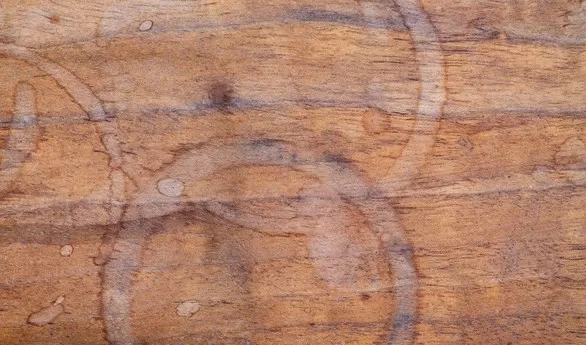Don’t Make It a White-Ring Christmas
This article has been republished. Images have been updated. Original date of publication: December 6th, 2015.

My latest little journey took me no further than from my living room to my workshop, for it was time for my annual “Save the Furniture” day.
‘Tis the season for guests, family, and friends, along with egg nog, wine, and fortified spirits intended to get us through the next few weeks. All will apply as much pressure on our furniture’s thin line of defense as a third-and-long free safety blitz on a drop-back quarterback behind an aging offense line.
The problem, of course, is that we cannot tell by looking at our furniture just how strong the finish really is. Will it fold like a bad poker hand with the first ring of merlot, or will it withstand even a greasy hors d’oeuvre discreetly hidden behind a Weller vase on your two-door Limbert bookcase?
This time of year people too often dash about the house with an old dishtowel loaded with lemon oil, wiping off dust and leaving behind a deceptive sheen of shimmering oil that immediately begins to evaporate. The wafting aroma may be as pleasing as a fresh bowl of potpourri, but the sad truth is that lemon oil provides absolutely no protection for any furniture finish.
Furniture polishes, including those that contain watered-down beeswax and anything in an aerosol can, are even worse, for they leave behind a sticky film that can actually soften an antique shellac finish.
So, what are we left with?
A time-honored finish and preservative:
Paste wax.
A high quality paste wax comes in a can, not a squeeze bottle, for the best brands contain Brazilian carnauba – the strongest wax available. They are a true paste, so require old-fashioned elbow grease for application.
Before I step back and give the paste wax time to set up, I give the fresh wax a final swipe going in the direction of the grain of the wood to remove any swirls left by my cloth. I switch to a clean, soft cloth, then wait and watch, checking the wax every few minutes until the time is right to start buffing.
Start too soon, and you’ll just wipe off your fresh wax.

Wait too long, and you’ll soon be dropping beads of sweat as you vigorously work to buff out the application marks left by your cloth.
When the time is just right – and that depends on the temperature and the humidity in the room – your buffing rag won’t pick up any wax, and instead will leave in its wake a pleasing semi-gloss sheen of real protection.
Do keep in mind, however, that paste wax is not impenetrable. A steaming mug of hot cider can slowly melt it, as will a splash of scotch left on it for several minutes. What it does is give us time to wipe up spills, knowing that the wax will bear the brunt of the burden until we come to the rescue with a damp cloth.
To help your paste wax protect your furniture, both vintage and contemporary, make sure you have the following on hand: heavy placemats under dinner plates; drink coasters on every horizontal surface; small plates for hors d’oeuvres; saucers under poinsettia plants and candles; trivets for hot serving dishes; and small stacks of paper napkins everywhere – so your guests can hopefully clean up their own accidents while you are in the kitchen.
Remember, too, that freshly cut evergreen bows and holly stems arranged as a centerpiece will leach sap that can also stain and damage a finish.
And unlike leftovers, the hard shell of paste wax protection will last for several months, letting both you and your furniture breathe a sigh of relief as you recuperate.
Until next Monday,

“What others say of me matters little; what I myself say and do matters much.”
– Elbert Hubbard
Bruce
For information on the National Arts and Crafts Conference to be held at the Omni-Grove Park Inn, please go to www.Arts-CraftsConference.com.
